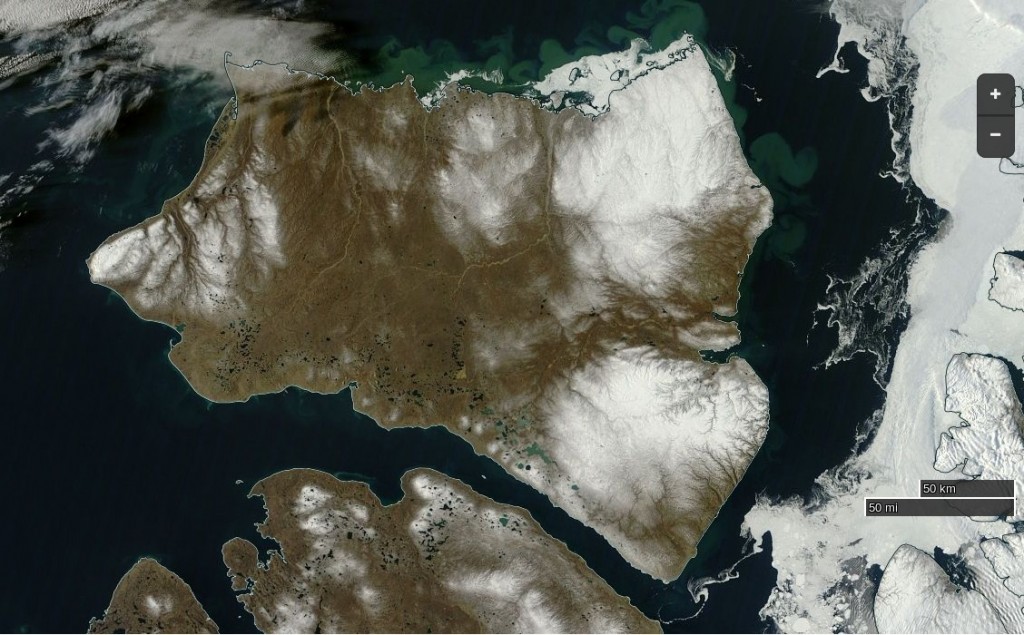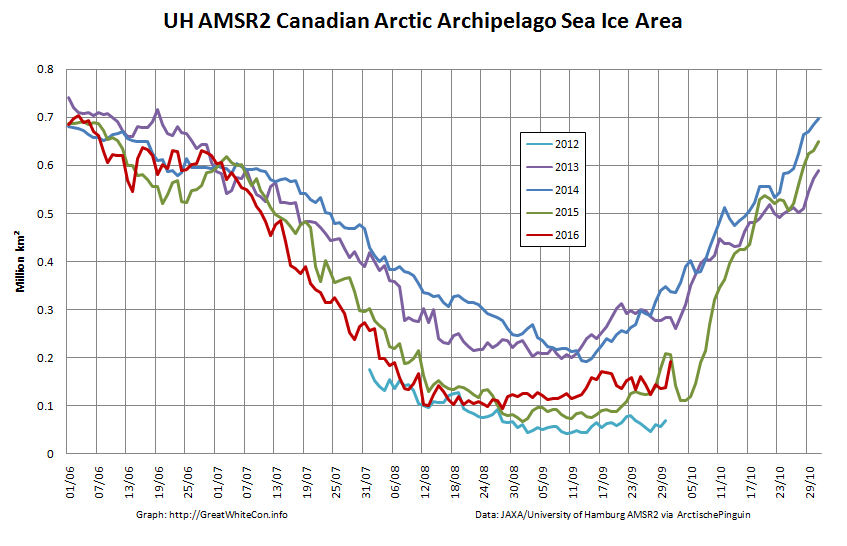A reader writes to ask us to explain the answer to the above question in more detail. Are you sitting comfortably once again? Then let us begin.
There has been a lot of unusual “weather” in the Arctic over the last twelve months. First of all there was an anomalously warm winter:
Then came what we dubbed the Great Arctic Anticyclone of 2016 in April. Take a look at what happened to the sea ice north of Alaska and Canada during the Spring and early Summer:
The ice was put through the mincer for the first time. Then during August there were a series of strong cyclones, collectively the Great Arctic Cyclone of 2016. The ice was put through the mincer once again, but in an anti-clockwise direction this time. Watch what happens in the Northwest Passage as summer turns to Autumn:
Some of the oldest, thickest ice in the Arctic has been chopped into small pieces which then easily flow through the channels of the Canadian Arctic Archipelago and into the Northwest Passage. Hence when the yacht Northabout (amongst others) was racing to reach Baffin Bay it wasn’t to avoid “the refreeze” as claimed in certain quarters. It was in fact to try and avoid the worst of the chopped up chunks of old sea ice being carried swiftly in their direction by winds and currents. Here’s what some of them looked like in close up:
The next question then becomes, if the Northwest Passage wasn’t refreezing then, is it freezing now? The answer is not yet. In fact the favourite talking point of the cryodenialista, McClure Strait at the western end of the “main” route through the Passage has recently become navigable:

which is confirmed by the latest Canadian Ice Service chart of the area:
The “pretty pink” area towards the top left of the chart reveals “new ice”. The Northwest Passage will have started to refreeze when some of that shows up on a “stage of development” chart of the Passage itself, but that hasn’t happened yet. Here’s yesterday evening’s chart of the “Approaches to Resolute“:
Lots of old ice! It was raining in Resolute yesterday, and the old ice there was still melting:
No sooner said than done! This evening’s ice charts from the CIS do now show some “pretty pink” new ice in the Northwest Passage:
The wispy areas of new ice are also visible on this “false-color” image of the Parry Channel:

However even if Northabout were still in Prince Regent Inlet she wouldn’t be “trapped in ice”. There is still a way back to Bristol via Fury and Hecla Strait:
That route has been remarkably busy this year!
A clear view of McClure Strait from the Terra satellite in “false colour”:

The inclusion of some infra red reveals the thicker old ice on the right noticeably paler than the new ice to its left. Compare also with the CIS ice chart, which has been rotated to match the orientation of the satellite image:
Pretty patterns in the new sea ice forming at the western entrance to McClure Strait:

The freshly frozen new ice in the Northwest Passage has been spotted by the AMSR2 instrument aboard the Japanese “Shizuku” satellite:
On the latest CIS “stage of development” chart the brown “old ice” has turned to deep red “multi-year ice”, and there’s lots more pretty pink out in the Beaufort Sea:









Several errors but close enough for the public who really don’t care to know the details of the Arctic when the Media keeps shouting its melting and will be ice free by dates already past which speaks volumes re Global Warming… its happening so don’t get you knickers in a knot without researching – pretty hard since recorded climate data is relatively short lived – compared to carbon dating of this planet’s millions of years of existence – but let the most recent science research effort taken by drilling through Greenland ice glaciers into earth’s sediments below has revealed many cycles of warming – cooling dating back hundreds-of-thousands of years – so today’s grain of sand lying on a beach of non-recorded climate data, i.e. by satellites is only 12 years that NASA claims has decoded climate change is just not good enough science in the scheme of things – it’s a peek or poke at best. Melting or Freezing? That’s easy to answer – BOTH, it depends on when you ask or want to know – is that for the entire year or a particular month? Where in the Arctic? Most recent – today – September of 2016 in McClure Strait it depends on the date – CIS stopped daily sea ice reporting for ship navigation in the strait about 20160918 but as an anomaly published on September 21 the previous week’s data showing the obvious sea ice decline (melting?) along the north shore of Banks Island – but just across the strait – on the North side of McClure Strait along the southwest side of the Parry Islands the sea is filled with concentrated pack ice – so this location would not be considered melting or freezing by myself… so wait a few more weeks and the minimum sea ice season of decline will be more wide spread by area – it had already been declared in equilibrium on or about September 11th so if you don’t like that answer – collect your own data and hypotheses. Does it really matter to the public? Only if you have additional data to further some other hypothesis… for me, I’m just interested in identifying trends which may assist in navigating the Northwest Passage – that’s my only reason for a dog in this rhetoric. BTW Jim – Route 1 through McClure is NOT the main route but IS the original first discovered NW Passage route by Robert McClure. And just so you are on the straight and narrow there are SEVEN routes when transiting the NW Passage, so please be specific if possible. Sail on!
Welcome Doug,
What specifically are the “errors” of which you speak? I’ll take “close enough” as a compliment shall I?
The 7 routes are itemised here.
I put “main” in quotes to indicate that route 1 is not in fact the route most travelled . Merely touted as such by the cryodenialista.
The McClure Strait chart above is from September 26th. This one is from the 28th:
revealing no way through at present, without an icebreaker at least!
More on the history of the Northwest Passage, McClure, Franklin et al. can be found here.
Thanks for the link here Jim.